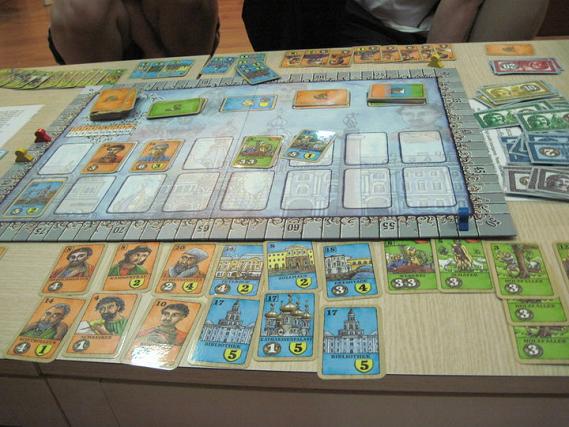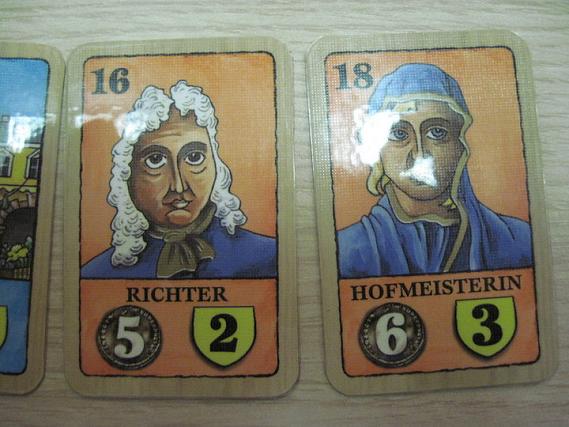7 Oct

The board and cards are very simple. In fact, if it weren’t for the need to track points, I think you could play without the board entirely.
This is an older game than we played recently at CarcaSean. Considering its age, I’m not going to cover rules and mechanics in detail. So here are my thoughts:
- Sean specifically noted that the art is done by the same person who worked on Carcassonne. While I think the art in Carcassonne has a rustic style that fits in well with all the landscape elements on the tiles, it doesn’t work for me in Saint Petersburg, which mainly has a lot of portraits. I’d have preferred a more detailed, heavier art style.
- This is another of those Euro games in which the theme is completely irrelevant. I’m especially disappointed with this as I was curious about it would do with the Russian tsars as its background. Its not a theme that comes up very often after all. It turned out that it didn’t serve any purpose except to provide some art ideas and names for the cards used.
- That said, I quite like this game. This is a bit odd for me as it’s a very naked engine-building game. My wife correctly identified it as being fundamentally very similar to Scepter of Zavandor, which I hated. In this game, you buy cards from the common pool available and visible to all players. Mostly, the cards either give you points or give you money to buy more cards.
- What makes this game distinctive is that a maximum of eight cards can be available in the pool for purchase and so new cards can enter the pool only after some have been bought. So buying the correct number of cards each phase is important to open slots as needed for the next phase. This is dependent on the turn order, which is different for each phase. For example, if you’re second in turn order in the aristocrats phase, you need to make sure that there are at least two open slots when that phase arrives so you can buy something. It’s a very neat twist.
- To help you fiddle with the slots, you can also choose to take a card into your hand instead of buying it, and then buy it from your hand later as an action. You can only keep a maximum of four cards like this however and you’re penalized for each card you’re still holding at the end of the game. But it seems like knowing what cards to put in hand and when to do so is a key skill in this game.
- Some cards offer additional abilities, such as allowing you to spend money to buy points or to hold an additional card in your hand. Only Sean bought those in our game. You probably need some experience with this game to understand their value and how they should be used.
- Some parts of the game do seem scripted to me. Sean even straight up told us that in the first phase of the game, the worker phase, everyone should just buy worker cards from the cheapest to the most expensive and everyone should buy as many workers as possible. I also belatedly realized that when buying aristocrats, you should always buy the most expensive one available first and try to buy the cheap ones later, to give more time for the expensive ones to pay for themselves. I dislike game designs with such scripted moves, especially ones that are identical every time you play the game.
- Shan ended up winning this game, which peeved Sean off a little as he said himself that he’d played this game many times already. As she explained to me later, while Sean and I were busy trying to maximize our income and to figure out how many card slots to leave open for each phase, she concentrated only on buying cards that gave points and didn’t bother to manage her money supply. For my part, I grew alarmed with seeing the income Sean was getting from aristocrats and tried to buy more of them, neglecting the buildings in the process. I should have figured out that aristocrats are a very inefficient way of earning money.
- From what I can tell on BGG, it’s surprisingly decent game for two people as well, though I worry that it would become even more scripted in this case. Anyway, it’s a good game that I like well enough, but still, shame about the theme.

An example of what the cards look like. Perhaps some people will like this art style, but I don’t.
Written on October 7 2010 and is filed under Boardgames.
You can follow any responses to this entry through the RSS 2.0 feed.
You can leave a response, or trackback from your own site.
Leave a Reply